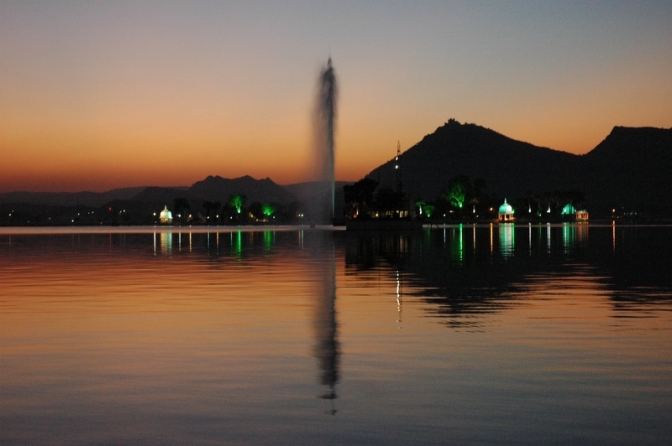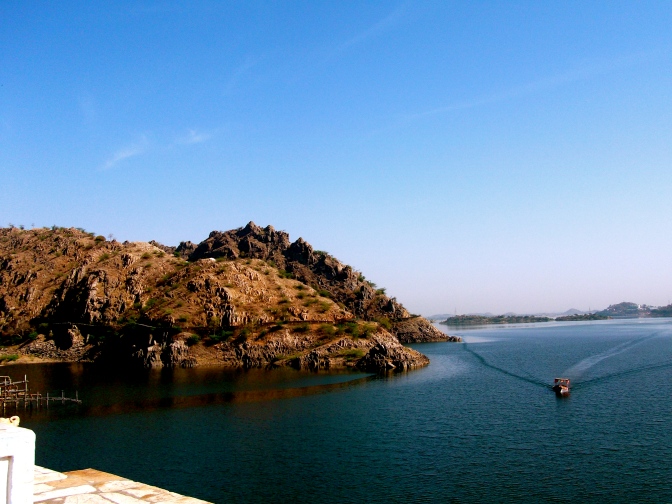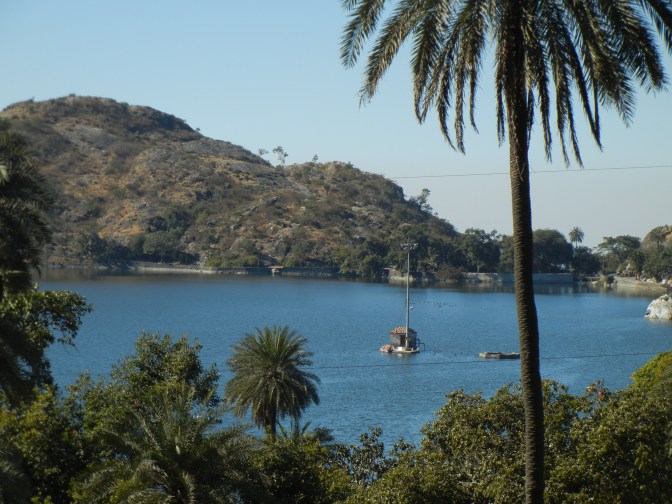By Payal Kavadia
Udaipur is fondly called “The city of Lakes”. Udaipur was the historic capital of Kingdom of Mewar, founded by Maharana Udai Singh in 1533.This province became a part of Rajasthan when India gained independence in 1947. I am proud and fortunate to be born and brought up here. It is not just known for its mesmerizing view, but also for its food (veg as well as non veg). It was also voted as the best city in the world in 2009 by the Travel + Leisure magazine. There are many blogs, sites etc. that talk about Udaipur, and the places to visit there. I have made my own list of places to visit and I try to visit them when I am there.

- Fatehsagar Lake: Fatehsagar lake is called the pride of Udaipur . This is one of the best man made lakes and its beauty increases as the sun sets. It is overlooked by a number of hills on three sides and has Nehru Park, a garden island, in the middle of the lake. One can take a boat ride to Nehru park. People enjoy the serene environment throughout the day whether strolling aimlessly early in the morning or chatting and socializing in the evening. For adventure enthusiasts, there are speed boat ride, scooter boat ride etc. There is something for everyone here. No wonder, Fatehsagar lake is a favourite amongst the localiites and tourists alike.

- Neemach Mata: Stone idol of Neemach Mata Devi is located on the banks of Fatehsagar lake on a hill of Dewali area of Udaipur. It is accessible through stairs and uphill slope walk way, whose length is around 900 metres. There is also an idol of Lord Ganesh and three west-facing lions made up of stone. The walk uphill is pollution free as no vehicles can enter in the hill boundary and the best time to visit Neemach Mata is morning. The view from this place is amazing. As i am writing this, i get the nostalgia of watching the entire udaipur city from one single point- the two lakes of udaipur, pichola and fatehsagar as well as the City Palace. Once a tourist is back to foothills, there is poha and garam garam cutting chai waiting to be relished at the Fatehsagar lake.

- Badi Lake: Badi lake is an artificial fresh water lake built in 1684 AD by Maharaja Raj Singh. It is situated in the north-east of Udaipur at a distance of 12 km from the city and covers an area of 155 sq km. It is a famous Sunset point as one can see the sun set behind the Aravalli hills while the sky is filled with a kaleidoscope of colours. Since the lake is devoid of commercial activity, it provides a serene and calm atmosphere to the visitors. One can reach Badi lake either by regular buses or by hiring taxis.

- City Palace: City Palace is the largest palace of Rajasthan with a façade 244m long and 30 m high. Its construction was started by Maharana Udai Singh II in 1599. This palace has been divided into two parts one for visitors and other is been converted into a hotel. Inside Badi Pol, on the northern end, eight arches on the left commemorate eight times when Maharanas were weighed here and their weight in gold or silver is distributed amongst the locals. The rooftop restaurant, gives the view of pichola along with all the nearby hotels and restaurants.. This palace makes for a picturesque setting when it is lit in the evening.

Monsoon palace, Sajjangarh, Udaipur - Monsoon Palace ( Sajjangarh fort) : Sajjangarh fort is the topmost point of udaipur and a hilltop palatial residence of Mewar’s rulers during the monsoon season. It was built by Maharana Sajjan Singh in 1884. It offers a panoramic view of Udaipur’s lakes, palaces and surrounding countryside. Not many may be aware that it was initially an astronomical centre before it became a monsoon palace and a hunting lodge. In the evening when the entire Udaipur city is lit up,one feels like staying in Sajjangarh fort and observing the magnificence of heritage of India.

Jaisamand Lake, Udaipur
- Jaisamand Lake: Jaisamand lake is the second largest artificial lake of Asia after Aswan dam of Egypt. It covers an area of 36 sq km and is 102 feet deep. It was built by Maharana Jai Singh in 1685, at a distance of 48 km from Udaipur. The lake comprises 7 islands, one of which is inhabited by a tribe. It is connected to all the major rivers that flow in Rajasthan during monsoon. Jaisamand lake is in close proximity to Jaisamand sanctuary, apt for wildlife enthusiasts. It is one of the best places to relax after a tiring week in the office. One can reach Jaisamand lake by hiring a taxi from Udaipur city.

Statue of Maharana Pratap commemorating the Battle of Haldighati, Udaipur - Haldighati and Kumbhalgarh Fort: Haldighati derives its name from ‘Haldi’ which means turmeric which is yellow in color due to the yellow soil in the area and ‘ghati’ that means valley. Haldighati is an important historical site in Rajasthan. This place boasts of the sacrifice made by Rana Pratap. He is one of the most courageous maharajas of Mewar, who single handedly fought against the Mughal emperor, Akbar. The palace sends a chill down the spine when one remembers how the loyal horse Chetak of Rana Pratapwas badly wounded but breathed his last only after ensuring that its master was safe. Thus, the battle has been recounted in murals and ballads. In fact, Col James Todd referred to Haldighati as the ‘Thermophile of Mewar’ on account of the ferocious battles fought, valor of soldiers and heart wrenching sacrifices. One can reach Haldighati by taking bus or by hiring a cab from Udaipur city.

Nakki Lake, Mt Abu, Rajasthan - Abu: Abu derives its name from Arbuada, the powerful serpent which rescued Nandi, the sacred bull of Lord Shiva. Thus, Abu means son of Himalayas. Mt. Abu is home to 33 crore Gods and Goddesses. It has been the home of many meditating rishi’s and muni’s. Situated 1219 meter above sea level, It is the only hill station of Rajasthan and north-west India. Mt Abu boasts of the highest peak of Aravallis, Guru Shikhar. It is well connected with Udaipur. It is a favorite summer holiday destination of not just residents of Rajasthan but also those of neighboring state of Gujarat. It is a 3 hour drive from Udaipur. This place is famous for Dilwara temples, its sunset point, boating in the evening, etc.

Dilwara Jain Temple, Mt. Abu, Rajasthan 
Intricately carved door in Dilwara Jain temple, Mt Abu Dilwara Jain Temple is one of the finest Jain temples of the world. It boasts of intricately carved ceilings and pillars. When one considers that they were constructed between 11th and 13th century AD, when there was no mode of transport or pucca roads, they make us realise that Dilwara Temples are one of the best examples of human craftsmanship. Incidentally, some people consider Dilwara temple, architecturally superior to Taj Mahal, a UNESCO World Heritage site.

Cultural show at Bagore ki Haveli - Gangaurghat: It is one of the ghats near pichola lake and is known for Bagore ki haveli. Gangaurghat is a popular destination for celebration of a number or cultural festivals including the gangaur festival. The festival is celebrated with so much pomp that the entire city comes to watch the visarjan of statues of Goddess Parvati, made of clay. These statues are made by the ladies at home. they dress them and pray for their husband’s long life. Similarly, Hanuman Ghat on the banks of Pichola lake is one of the most sought after tourist destinations in Udaipur.

Jagmandir island, Udaipur - Jagmandir Island: Jagmandir island is also known as Lake Garden palace. Its construction started in 1551 by Maharana Amar Singht, continued by Maharana Karan Singh and completed by Maharana Jagat Singh. The Royal family used it as a summer resort and place for holding parties. Maharana Karan Singh exhibited benevolence to Shahjahan (also called Khurram) before he became the Mughal emperor. Maharana Karan singh gave refuge to Khurram after he had revolted against his father Jahangir in the quest to become heir to the Mughal empire. Initially Khurram and his family were given refuge in City Palace but later, Maharana Jagat Singh built Jagmandir island for Khurram and his family. The island that boasts of rich history and heritage can be reached only by Bansi ghat jetty next to Lake Palace in Udaipur.
Not just from India, tourists from all around the world visit this beautiful city, and are overwhelmed with the beauty of this city.
Payal Kavadia is a homemaker and a first time blogger. She is a Digital marketer who has a sound academic background in Information Technology from SRM University. She worked in TATA Consultancy Services for 3+ years. Here, she opens up about her favorite place in the world.
